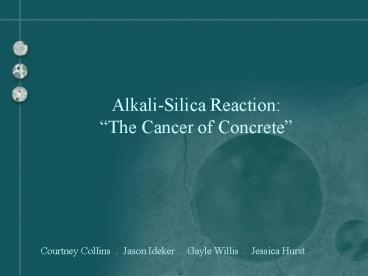Alkali-Silica Reaction: - PowerPoint PPT Presentation
1 / 26
Title:
Alkali-Silica Reaction:
Description:
Less reactive aggregates often expensive or difficult to find ... exerting a force against surrounding concrete. Creation of alkali-silica gel ... – PowerPoint PPT presentation
Number of Views:488
Avg rating:3.0/5.0
Title: Alkali-Silica Reaction:
1
Alkali-Silica ReactionThe Cancer of Concrete
Courtney Collins . Jason Ideker . Gayle
Willis . Jessica Hurst
2
Outline
- What is ASR and why is it important?
- How does ASR work?
- How can ASR damage be prevented?
3
What is ASR?
Alkali Silica Reaction (ASR)
Alkalis Reactive Silica Moisture
ASR Gel which expands
Concrete cracking
4
Concrete failure due to ASR
AASHTO Innovative Highway Technologies
AASHTO Innovative Highway Technologies
AASHTO Innovative Highway Technologies
Georgia Tech School of CEE - Courtney Collins
5
Why is it important to study ASR?
- Concrete quality
- Loss of strength, stiffness, impermeability
- Premature failure of concrete structures
- Economic/Environmental impacts
- ASR lowers concrete lifetime
- Less reactive aggregates often expensive or
difficult to find - Cement production creates 7 of the worlds
- CO2 emissions (a greenhouse gas).
6
Case Study Parker Dam, California
http//www.acres.com/aar/
Alkali-Aggregate Reactions in Hydroelectric
Plants and Dams
- Hydroelectric dam built in 1938
- 180 mm of arch deflection due to alkali silica
gel expansion - Cracking and gel flow in concrete
7
Case Study I-85 - Atlanta, Georgia
- Possible ASR damage on concrete retaining wall -
picture taken 1/2002
8
How does ASR work?
What we know
- Which reactants involved and their sources
- How alkali-silica gel is created
- ASR prevention can be achieved by using low
alkali cement and non-reactive aggregate - Additives such as lithium compounds and
pozzolanic material help prevent ASR damage
What we dont know
- Mechanism of gel expansion
- Lithium its mechanism of inhibition, which
compounds work best, how much of each compound is
needed to prevent expansion
9
Creation of alkali-silica gel
10
Creation of alkali-silica gel
Reactants alkalis, reactive silica, and water
Alkalis
- Main cations
- Sodium (Na)
- Potassium (K)
- Common sources
- Portland cement
- Deicing agents
- Seawater
11
Creation of alkali-silica gel
Reactive Silica
Silica tetrahedron
Amorphous Silica
Crystalline Silica
12
Creation of alkali-silica gel
Reactive Silica
Amorphous silica most chemically
reactive Common reactive rocks
opal obsidian cristobalite tridymite chelced
ony cherts cryptocrystalline volcanic
rocks strained quartz
13
Creation of alkali-silica gel
Water
- Found in pore spaces in concrete
- Sources
- Addition of water to concrete mixture
- Moist environment/permeable concrete
14
Creation of alkali-silica gel
1. Aggregate in solution, pre-ASR damage
15
Creation of alkali-silica gel
2. Surface of aggregate is attacked by OH-
H20 Si-O-Si
Si-OHOH-Si
16
Creation of alkali-silica gel
3. Silanol groups (Si-OH) on surface are broken
down by OH- into SiO- molecules
Si-OH OH-
SiO- H20
17
Creation of alkali-silica gel
4. Released SiO- molecules attract alkali
cations in pore solution, forming a gel
around the aggregate
18
Creation of alkali-silica gel
5. Alkali-silica gel takes in water, expanding
and exerting a force against surrounding
concrete.
19
Creation of alkali-silica gel
6. When the expansionary pressure exceeds
the tensile strength of the concrete, the
concrete cracks
20
Creation of alkali-silica gel
7. When cracks reach the surface of the
structure, map cracking results
21
Images of ASR damage
22
Images of ASR damage
23
Images of ASR damage
24
How to prevent ASR damage
25
How to prevent ASR damage
Alkalis Reactive Silica Moisture
ASR Gel
- Avoid high alkali content
- use low alkali portland cement
- replace cement with pozzolanic admixtures
- Avoid reactive aggregate (amorphous silica)
- Control access to water
- Use lithium additives prior to placement of
concrete or as a treatment in already existing
concrete
26
ANY QUESTIONS?































